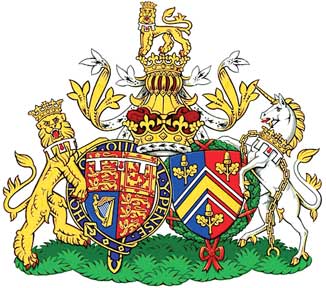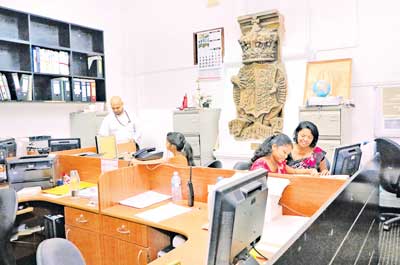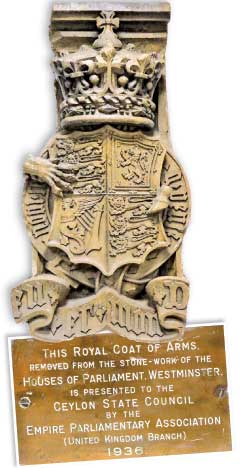Forgotten Royal ties
The Royal Court of Arms of the United Kingdom hidden
away in an unobtrusive corner in the Presidential Secretariat is a
reminder of a bygone era:
by Manjula Fernando
 |
|
Royal Coat of Arms
Pix : Saman Sri Wedage |
Mounted on a wall in an inconspicuous corner in the Presidential
Secretariat is a Royal Coat of Arms of the United Kingdom, a gift from
the UK branch of the Empire Parliamentary Association by which name the
Commonwealth Parliamentary Association was called at the time. Vestiges
of a bygone era, one may say. Such remnants are still found in places
one least expects.
This discovery comes at a time when Sri Lanka is preparing to
celebrate the 68th anniversary of Independence from British colonial
rule.
The Royal Coat of Arms is the official insignia of the British
Monarch. Other members of the Royal family as well as the British
Government use variants of the Royal Arms. Duke and Duchess of
Cambridge, William and Kate, has a conjugal (combined) Coat of Arms,
which was announced by the Kensington Palace after their marriage.
The nearly four-foot tall stone-work from the British Parliament in
1936 was gifted to Sri Lanka's State Council, a few years after it was
appointed in 1931.
The monument was placed at the old Parliament building (facing Galle
Face), which housed the State Council.
The history of this stone emblem was hard to trace.
The small library within the old Parliament which houses the
Presidential Secretariat today, had very little information on this
monument.
 |
|
Erected on a wall in an
inconspicuous corner inside the Presidential Secretariat is a
Royal Coat of Arms of the United Kingdom, a gift from the UK
branch of the Empire Parliamentary Association |
However, the Royal Coat of Arms still looked noble, although it has
lost its original grandeur.
A library document revealed that the British Coat of Arms adorned the
top of the facade of the State Council building until 1948, the year Sri
Lanka won Independence. It was thereafter replaced by the Arms of the
Dominion of Ceylon.
 |
|
The Royal Coat of Arms |
Later, in 1972, the Arms of the Dominion of Ceylon was replaced with
the arms of the Democratic Socialist Republic of Sri Lanka. It did not
describe how and when it was handed over.
Greek architecture
The old Parliament building housed the country's legislature for 53
years, till the new Parliament complex was opened in Sri Jayawardenapura
Kotte in 1983.
Inspired by Greek architecture, the old Parliament was originally
built to house the Legislative Council of Ceylon and the building was
opened by Governor Sir Herbert Stanley on January 29, 1930.
Much of the stone carving of the monument has withstood the test of
time. But the lion figure on the left of the stone-work and the figure
of the unicorn on the right is damaged somewhat.
This probably during the time it was removed from the original
location.
What is left of the two figures are only the two front legs of the
animals holding the crest.
The staff at the Secretary's Bureau, which is entrusted with handling
special projects by the President's Secretary, is currently in charge of
it.
"We don't know the history, but we regularly clean and dust it.
It was once given a special coat of paint to give the stonework the
current metallic hue," Ajith Wijeratne, a senior officer said.
The room where it stands today was the record room earlier.
An imprint on a brass sheet below the monument states, 'The Royal
Court of Arms' removed from the stonework of Parliament House in
Westminster is presented to the State Council by the Empire
Parliamentary Association. U.K.Branch, 1936."
According to the above description this gift by the Commonwealth
Parliamentary Association, a memorabilia of the colonial rule marks its
80th year this year. |

